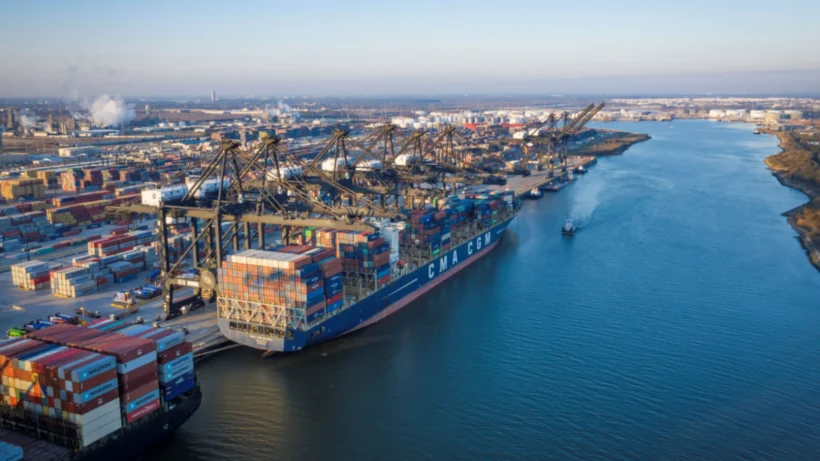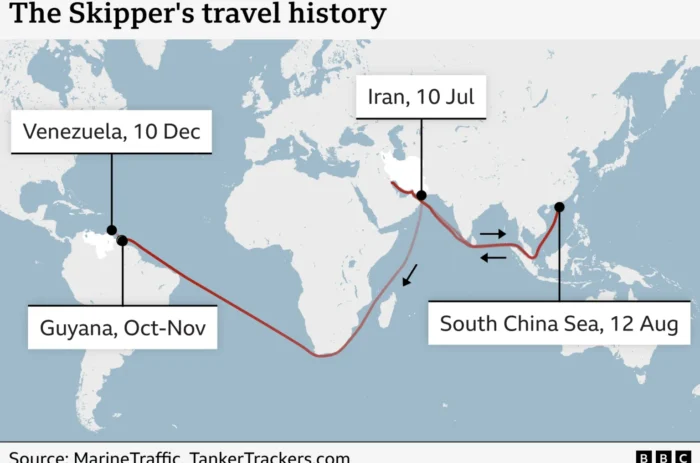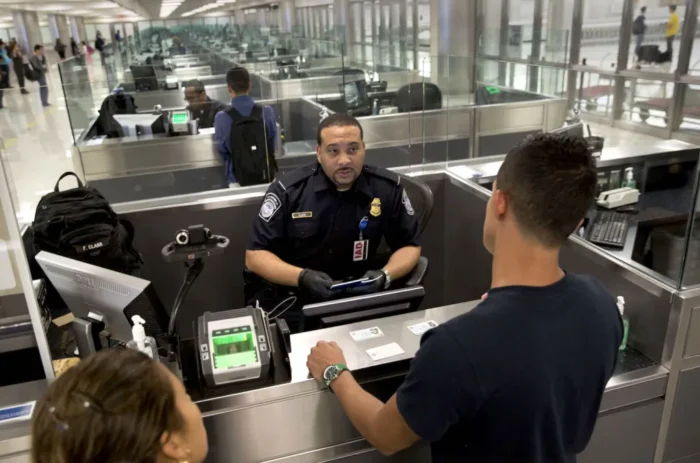
Port of Houston
redo Jump to...
print Print...
(by Tom Krisher, Associated Press) – Determined to thwart the automating of their jobs, about 45,000 dockworkers along the U.S. East and Gulf Coasts are threatening to strike on Oct. 1, a move that would shut down ports that handle about half the nation’s cargo from ships.
The International Longshoremen’s Union (ILA) is demanding significantly higher wages and a total ban on the automation of cranes, gates and container movements that are used in the loading or loading of freight at 36 U.S. ports. Whenever and however the dispute is resolved, it’s likely to affect how freight moves in and out of the United States for years to come.
If a strike were resolved within a few weeks, consumers probably wouldn’t notice any major shortages of retail goods. But a strike that persists for more than a month would likely cause a shortage of some consumer products, although most holiday retail goods have already arrived from overseas.
A prolonged strike would almost certainly hurt the U.S. economy. Even a brief strike would cause disruptions. Heavier vehicular traffic would be likely at key points around the country as cargo was diverted to West Coast ports, where workers belong to a different union not involved in the strike. And once the longshoremen’s union eventually returned to work, a ship backlog would likely result. For every day of a port strike, experts say it takes four to six days to clear it up.
“I think everyone’s a bit nervous about it,” said Mia Ginter, director of North America ocean shipping for C.H. Robinson, a logistics firm. “The rhetoric this time with the ILA is at a level we haven’t seen before.”
The longshoremen’s union and the United States Maritime Alliance (USMX), which represents the ports*, haven’t met to negotiate since June, when the union said it suspended national talks to first complete local port agreements. No further national contract talks have been scheduled. [*The Maritime Alliance is a non-profit organization that represents employers in the longshore industry on the East and Gulf Coasts of the U.S. USMX’s members include: container carriers, marine terminal operators, and port associations.]
Harold Daggett, the union president, warned earlier this month that the longshoremen stood ready to strike once their contract expires on Sept. 30.
“We are very far apart,” Daggett said. “Mark my words, we’ll shut them down Oct. 1 if we don’t get the kind of wages we deserve.”
Top-scale port workers now earn a base pay of $39 an hour, or just over $81,000 a year. But with overtime and other benefits, some can make in excess of $200,000 annually. Neither the union nor the ports would discuss pay levels. But a 2019-2020 report by the Waterfront Commission, which oversees New York Harbor, said about a third of the longshoremen based there made $200,000 or more.
Daggett contends, though, that higher-paid longshoremen work up to 100 hours a week, most of it overtime, and sacrifice much of their family time in doing so.
The Maritime Alliance has said it’s committed to resuming talks and avoiding the first national longshoremen’s strike since 1977. It has accused the union of having already decided in advance to walk off the job.
“We need to sit down and negotiate a new agreement that avoids an unnecessary and costly strike that will be detrimental to both sides,” the alliance said in a statement.
In the case of a short-lived strike, industry experts say consumers wouldn’t likely notice shortages of store goods during the holiday shopping season. Most retailers had goods transported ahead of the usual pre-holiday shipping season, and they’re already stored in warehouses. …
If a strike were to extend beyond a month or so, spot shortages of goods could develop. Some manufacturers could run short of parts, notably in the auto and pharmaceutical industries, which generally don’t stock large parts inventories. Exports of autos and other goods that move through the East Coast also could be affected. …
Analysts say the union’s initial demands included a 77% pay raise over the course of a six-year contract. Daggett, the union president, said sizable pay raises would make up for the inflation spike of the past few years.
And he said it would give workers a share of the billions the companies have earned, especially during the pandemic. Copenhagen-based Maersk, among the world’s largest container shipping companies, made more than $50 billion in profits over the past four years. Earnings, though, dropped substantially in 2023 as pandemic-era consumer demand eased and brought sky-high freight rates back down.
Daggett said the union members expect to be waging their biggest fight — against the automation of job functions at ports — well into the future.
“We do not believe that robotics should take over a human being’s job,” he said. “Especially a human being that’s historically performed that job.”
As an example, he pointed to a gate that automatically processes trucks without union labor at the port in Mobile, Alabama. The gate has been in place since 2008.
The Maritime Alliance has said it offered, as part of a new contract, to keep current provisions that bar fully automated terminals and block the use of semi-automated equipment without an agreement from both sides on protecting human jobs.
Experts say it’s not altogether clear whether automation would lead to layoffs. …..
In the meantime, if there is a strike, analysts say West Coast ports could pick up at least some additional freight that might be diverted from Eastern ports, especially from Asia. But they couldn’t handle it all. Neither could the U.S. rail system.
“The East Coast has grown a lot,” Ben Nolan, a transportation analyst with Stifel said. “There’s just no way to get around it.”
Published at AP .com (Associated Press) on September 18, 2024. Reprinted here for educational purposes only. May not be reproduced on other websites without permission.
Questions
1. The first paragraph of a news article should answer the questions who, what, where and when. List the who, what, where and when of this news item. (NOTE: The remainder of a news article provides details on the why and/or how.)
2. a) How many ports will be affected?
b) How much of the cargo coming into the U.S. comes through these ports?
c) What are the union’s two main demands in making a new agreement with the Maritime Alliance?
3. a) List the effects of a potential monthlong dockworkers strike.
b) What is the good news for consumers if the longshoremen were to strike?
4. a) What warning did union president Harold Dagger give earlier this month?
b) How much money do longshoremen make? How much can they make with overtime?
c) Mr. Dagget points out that longshoremen work up to 100 hours/week to make that kind of overtime. Why do you think a longshoreman would work so much overtime?
5. a) In what year was the last national longshoremen’s strike?
b) Most companies offer raises within a 3-5% range per year. Payroll firm ADP noted that workers who stayed in the same job reported a 4.8% yearly increase. What average yearly increase are the longshoremen asking for? How does union president Dagger explain this amount?
c) Ask a parent or other adult what percent annual increase they usually receive in their job. (Try to find one union and one non-union employee to ask.) Then ask, considering inflation (the skyrocketing cost of everything), do you think the union is being unreasonable to the Maritime Alliance? Please explain your answer.
d) Something to consider: every employer is also experiencing the problems from inflation. Not every employer will be able to increase employees salaries to cover inflation. Which presidential candidate do you think is more likely bring down inflation: Kamala Harris or Donald Trump? If you are not sure, ask a parent (or grandparent).
6. Regarding the second demand about automation, Dagger said:
“We do not believe that robotics should take over a human being’s job. Especially a human being that’s historically performed that job.”
a) What is your reaction to this argument? Agree or disagree? Explain your answer.
b) A concern not mentioned in this article: many/all? U.S. ports use cargo cranes made in China. President Biden recently ordered ports to purchase cargo cranes made in the US over fears of Chinese espionage or hacking (Chinese or other nefarious individuals or groups), which could bring port business to a halt. Should concern over hacking which could disrupt our cargo shipping business be a reason to keep humans in these jobs? Explain your answer.
CHALLENGE QUESTION: Since mid-November 2023, the Yemen-based, Iran-backed Houthi terrorist group has attacked dozens of commercial ships in the Red Sea, with no signs of slowing down. The terrorist group’s attacks on ships in the Red Sea have significantly impacted global shipping, including U.S. shipping, in a number of ways:
- Shipping routes: The attacks have caused major disruptions and delays to global shipping routes, especially through the Suez Canal.
- Shipping companies: The attacks have strained shipping companies financially, forcing them to divert around Africa.
- Global supply chains: The attacks have had a drastic impact on global supply chains.
- Global trade: The attacks are disrupting global trade.
- U.S. consumers and taxpayers: The attacks will impact U.S. consumers and taxpayers.
- Global shipping companies’ investment decisions: The attacks have forced global shipping companies to make long-term investment decisions, such as purchasing additional ships.
RADM (Ret.) Mark Montgomery said: “These Houthi attacks are occurring almost daily. The United States is spending billions of dollars in a defensive effort to engage missiles in flight or destroy them on the ground in Yemen. If Washington wants to deter these attacks, we need to cut off the supply chain of missiles and parts to the Houthis at the source — Iranian ships and ports.”
(Read more at: Top Shipping Company Warns of Global Impact of Houthi Attacks on Vessels in Red Sea)
Which presidential candidate do you think is more likely to stop the Houthi terrorist attacks? Explain your answer.
Background
Longshoremen, also known dock workers, perform a variety of tasks at ports and terminals, including:
- Loading and unloading cargo: Longshoremen use cranes, lifts, and clamps to move cargo of different sizes and weights onto and off of ships.
- Operating heavy equipment: Longshoremen operate forklifts, diesel pushers, and other machinery. They also maintain and repair mechanical parts of conveyors and bulk material handling equipment.
- Inspecting cargo: Longshoremen inspect cargo and track its movement using an inventory control system.
- Processing paperwork: Longshoremen process paperwork for shipments.
- Cleaning: Longshoremen perform clean up activities in the dock area.
- Working in all weather conditions: Longshoremen work outdoors in all types of weather.
- Working in a dangerous environment: Longshoremen work in a dangerous environment with high vehicle traffic and heavy equipment.
- Longshoremen need to be strong, agile, and have good eyesight and coordination. They also need to be able to read and interpret documents, and communicate clearly with colleagues and supervisors. (From Generative IA from a google search)
- Indeed .com notes: Most employers require a high school education or GED to hire longshore professionals. You can also benefit from formal training as an equipment operator. Obtaining your crane and forklift certification shows that you can safely handle the necessary tools.
Read more: What Does a Longshore Worker Do? (With Duties and Skills)
https://ca.indeed.com/career-advice/finding-a-job/what-does-longshore-worker-do
From the AP article above:
Experts say it’s not altogether clear whether automation would lead to layoffs.
A 2022 study by the Economic Roundtable of Los Angeles that was funded by the West Coast dockworkers union found that automation cost 572 jobs each year in 2020 and 2021 at partially automated terminals at the ports of Long Beach and Los Angeles.
But another study that same year by a professor at the University of California, Berkeley, that was commissioned by port operators and shippers concluded that between 2015, when Los Angeles-area ports adopted some automation, and 2021, paid hours for port union members grew 11.2%.
At the huge Port of Rotterdam, one of the world’s most automated ports, union workers pushed for early-retirement packages and work-time reductions as a means to preserve jobs. And in the end, mechanization didn’t cause significant job losses, a researcher from Erasmus University in the Netherlands found.
U.S. ports trail their counterparts in Asia and Europe in the use of automation. Analysts note that most U.S. ports take longer to unload container ships than do those in Asia and Europe and suggest that without more automation, they could become even less competitive. Shippers might send more cargo to Mexican or Canadian ports and then on to the U.S. by rail or truck, said Eleftherios Iakovou, associate director of supply chain resilience at Texas A&M University.
He suggested that the two sides discuss the use of automation to augment the functions of human workers rather than to displace them.
Any final reckoning over automation, though, remains a long way off. For shippers to abandon U.S. ports, Mexican ports would have to become more efficient at the same time that U.S. ports became “prohibitively inefficient,” said Stifel’s Nolan.
“I do think there’s some validity to it, but it’s not a this-decade kind of issue,” he said.
Resources
Watch a September 11, 2024 News Nation report:
Watch a September 19, 2024 NJ News12 report:
Daily “Answers” emails are provided for Daily News Articles, Tuesday’s World Events and Friday’s News Quiz.



